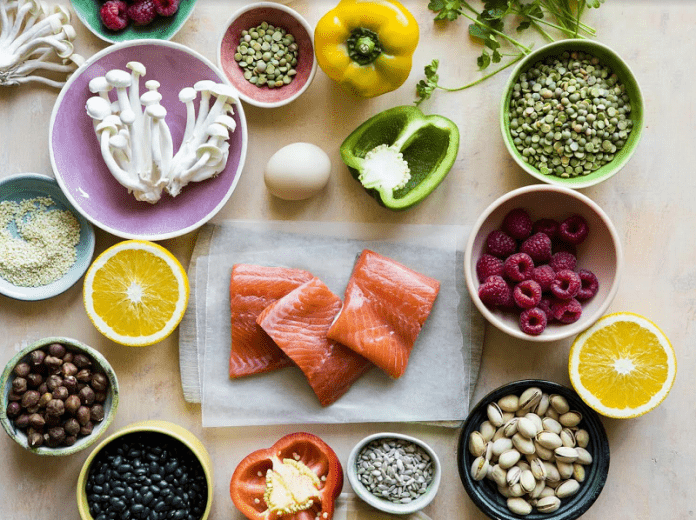Proteins are large, complex molecules comprising of hundreds or thousands of smaller units called amino acids, which are attached to one another in long chains. Proteins do most of the work in cells and are required for the structure, function, and regulation of the body’s tissues and organs. Proteins differ from one another primarily in their sequence of amino acids, which is dictated by the nucleotide sequence of their genes, and which usually results in protein folding into a specific three-dimensional (3D) structure that determines its activity.
There are 20 different types of amino acids that can be combined to make a protein. While some can be synthesized by the human body, others cannot. The nine amino acids that the body cannot make are called essential amino acids. These must be obtained through diet.
When a person eats protein, it is digested and broken down into amino acids, which are involved in many processes in the body, including tissue growth and repair, immune function, and energy production. Once formed, proteins only exist for a certain period and are then degraded and recycled by the cell’s machinery through the process of protein turnover. A protein’s lifespan is measured in terms of its half-life and covers a wide range. They can exist for minutes or years with an average lifespan of 1–2 days in mammalian cells.
Like other body tissues, muscle proteins are continuously broken down and rebuilt. In order to build muscle, a person must consume more protein than what is broken down. This is often referred to as a net positive nitrogen balance, as protein is high in nitrogen.
If a person is not consuming adequate amounts of protein, their body tends to break down muscle to provide the body with the amino acids needed to support body functions and preserve more important tissues. Over time, this can lead to decreased muscle mass and strength. Additionally, the body uses amino acids for muscle protein synthesis (MPS), the primary driver of muscle repair, recovery, and growth after strenuous exercises.
According to the 2020-2025 Dietary Guidelines for Americans, most healthy adults over 19 years old should get between 10 to 35 percent of their daily calories from protein. One gram of protein provides 4 calories. This means that a person who eats 2,000 calories per day would need to consume between 50 and 175 grams of protein per day.
The current Recommended Dietary Allowance (RDA) of 0.8 g per kg of body weight for protein is based on the amount required to maintain nitrogen balance and prevent muscle loss. However, extending these recommendations to active individuals who are looking to build muscle may not be appropriate.
When it comes to building muscle mass, the ideal amount of daily protein a person should consume depends on several factors, including age, gender, activity level, health, and others. Nevertheless, previous studies have given us a good idea of how to calculate the amount of protein adults need for muscle gain based on body weight.
While most studies agree that higher protein intakes are associated with improvements in lean body mass and strength when combined with resistance training, the optimal amount of protein required to build muscle remains controversial.
One 2020 meta-analysis found that protein intakes ranging from 0.5 to 3.5 g per kg of body weight can support increases in lean body mass. In particular, researchers noted that gradually increasing protein intake, even by as little as 0.1 grams per kilogram of body weight per day, can help maintain or increase muscle mass.
While it is difficult to give exact figures due to varying study results, the optimum amount of protein for muscle-building appears to be between 1.2 and 1.6 g per kg of body weight. Although the rate of increase in lean body mass from higher protein intakes rapidly decreased after 1.3 g per kg of body weight was exceeded, strength training was found to suppress this decline. This suggests that increased protein intake paired with strength training is best for gaining lean body mass.
For example, this means a 80 kg male would need to consume between 98 and 131 g of protein daily, combined with resistance training, to support muscle growth. A person can meet their daily protein needs by eating animal and plant-based protein sources. However, most research suggests that eating more than 2 g of protein per kg of body weight per day can cause health issues over time. However, when combined with resistance training, protein intakes above the current RDA can support muscle building.
Some nutritionists consider animal protein sources to be superior to plant-based protein sources when it comes to building muscle mass, as they are complete proteins and contain all the essential amino acids the body needs in sufficient amounts. They are also easy to digest. Animal-based protein sources include: lean meats (beef, pork, or lamb), poultry, eggs, fish and seafood, dairy products, and whey protein powders among others.
Some experts consider most plant proteins to be incomplete proteins because they do not contain all essential amino acids. However, individuals can pair incomplete protein sources to form a complete protein. Examples include rice and beans, hummus and pita bread, or peanut butter on whole wheat bread. Plant-based protein sources include: beans, peas, nuts, lentils, seeds, soy products, and plant-based protein powders.
However, doctors suggest that since the optimal amount of protein a person needs depends on age, health status, and activity level, it would be better to seek professional advice from a healthcare provider or a registered dietitian before deciding how much protein is suitable for you.

















